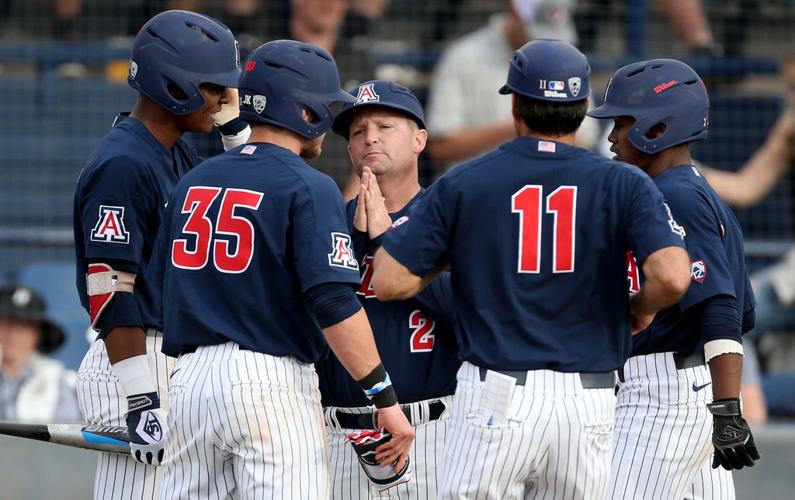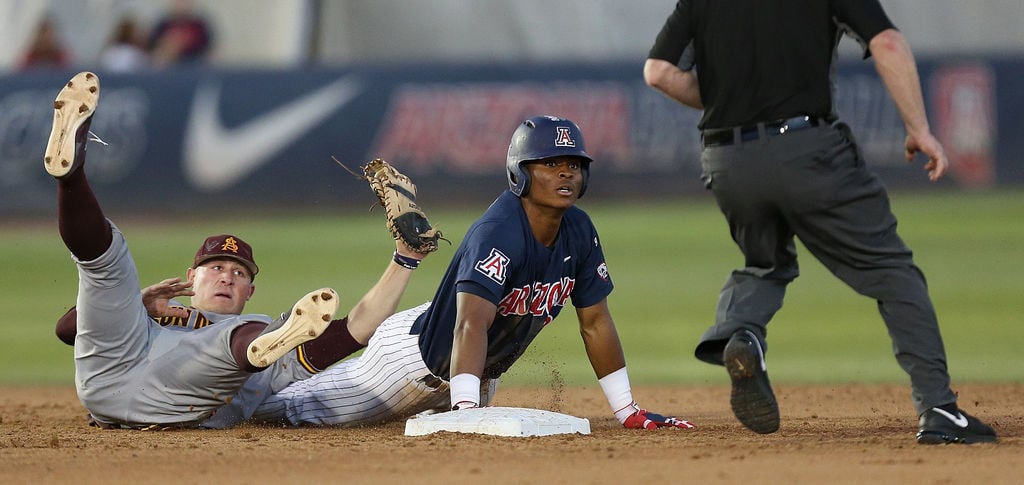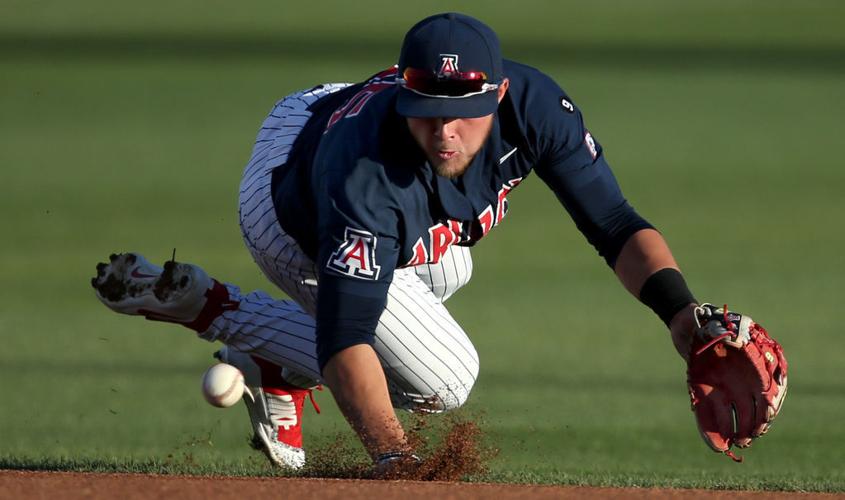In his three seasons as coach of the Arizona Wildcats, about the only mistake Jay Johnson has made — if you want to call it that — was setting the bar at an unsustainably high level.
Johnson led Arizona to within a hit of the College World Series championship in Year 1. It was a nearly impossible act to follow.
The Wildcats made the NCAA Tournament the next season and fell just short this year, landing among the first four out when the field was announced Monday.
Skeptics might look at those three seasons and see a program trending downward. The truth is, Johnson has helped re-establish Arizona as one of the top programs in the Pac-12.
“We put Arizona back on the radar,” said junior catcher Cesar Salazar, who’s been with Johnson every step of the way. “We were kind of under the radar after 2012. When Johnson took over the program, he lifted it up big time.”
The Wildcats won their fourth national championship in 2012. Although deserving in ’13, they didn’t make the NCAA Tournament in any of the following three seasons.
Arizona won 87 games during that span under Hall of Fame coach Andy Lopez. The Wildcats have won 121 over the past three seasons under Johnson. Arizona also achieved a 10-game improvement in league play.
The overall win total from 2016-18 ranks second in the conference, trailing only Oregon State’s 135. Arizona ranks third in total wins over the past two seasons (72) behind OSU (100) and Stanford (86).
Although he rarely references big-picture expectations, preferring to focus on incremental, daily improvement, Johnson laid out some lofty goals Monday. He said he’d like to see his program “make a jump” to Stanford and Oregon State’s level. They’re the Nos. 2 and 3 national seeds in the NCAA Tournament, which begins Friday.
Which area can the Wildcats get significantly better? As Johnson often says, it all starts on the mound. The Cardinal and Beavers have elite starting pitching. Arizona’s staff as a whole did not perform as well the past two seasons as the one that at times carried the Cats to the CWS finals in 2016.
Arizona had a 3.18 ERA in ’16. It was 4.36 last year and 3.95 this year.
If they didn’t score at least four runs, the 2018 Wildcats rarely won. They were 2-16 in games in which they scored three or fewer.
Arizona also had trouble finishing games. For the season, the Wildcats outscored their opponents in each of the first eight innings. They were outscored 26-14 in the ninth inning and 3-1 in extra innings.
Arizona will lose No. 1 starter Cody Deason (6-5, 2.87 ERA) but has some promising pieces returning. Redshirt sophomore Randy Labaut, who missed more than two months because of a leg injury, could succeed Deason as the Friday night starter. The strike-throwing left-hander had a 1.60 ERA and a 0.92 WHIP in 33º innings.
Right-hander Zach Sherman looked like a future closer, allowing only 13 hits and striking out 24 in 18ª innings. He finished his redshirt-freshman season with a 2.45 ERA and 0.98 WHIP.
Freshman left-hander Gil Luna became one of Johnson’s most trusted relievers down the stretch. Luna struck out 32 batters in 23º innings.
Despite losing top hitters Salazar (.339, four homers, 42 RBIs) and Alfonso Rivas III (.342-7-52), plus center fielder Cal Stevenson (.416 on-base percentage), Arizona returns the majority of a potentially potent lineup.
Infielders Cameron Cannon and Nick Quintana blossomed as sophomores. Cannon, who played second base and shortstop, had eight home runs, 50 RBIs and a .321 batting average. He led the team in doubles (21), walks (37) and runs (59).
Third baseman Quintana led the team with 14 homers and 55 RBIs while batting .313. He hit all 14 home runs in Arizona’s final 34 games.
Right fielder Matt Fraizer, also a sophomore, made significant strides in his first year as a starter. After a slow start, Fraizer finished with a .266 average, a .352 on-base percentage and nearly as many walks (25) as strikeouts (27).
The freshman class also yielded multiple starting-caliber players. They include middle infielder Jacob Blas, who batted .305, and outfielder Donta Williams, who had a .395 on-base percentage. Both appeared in 43 of 56 games. Blas started 35, Williams 24.
Catcher will be the hardest spot to replace. Sahuaro High School’s Salazar, who’s projected to be selected in the first 10 rounds of next week’s MLB draft, started most of the past three seasons. He had an excellent defensive backup in Ryan Haug, who has used up his eligibility.
Arizona is hopeful that class-of-2018 catcher Austin Wells will make it to campus. Wells, from Bishop Gorman High School in Las Vegas, is ranked 206th among Baseball America’s top 500 MLB draft prospects. Other catcher possibilities include transfers Matt Dyer and Michael Berglund.
Johnson struggled to quantify how much Salazar meant to the UA program.
“I have a lot of favorite players. He’s my favorite player I ever coached,” Johnson said. “It’s almost hard to talk about. There’s not a better human being on the planet than him.
“To give you an example, he lined out to center field (in his final UA at-bat Saturday). We had to take him out because he got a bad bruise on his knee early in the game. He was like, ‘Sorry I didn’t get that last run in for us.’ You hit a line drive to center field. You’re playing on one leg.
“Totally irreplaceable person. I can’t say enough about him.”
The feeling is mutual, and Salazar’s fondness for Johnson — “He’s like my father,” Salazar said — isn’t uncommon. That players want to play for Johnson and his staff, who have proved they can mold and develop pro prospects, is among the chief reasons many are bullish on Arizona’s future.
“The best is yet to come,” Salazar said.






